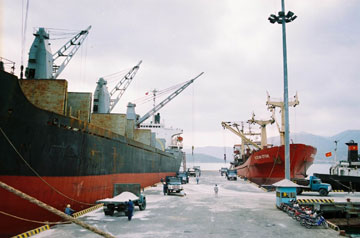
Cam Ranh Port, located in Cam Ranh Bay of Khanh Hoa Province has become an important centre of marine traffic covering the economic zone of south Khanh Hoa and neighboring provinces...
Cam Ranh Port, located in Cam Ranh Bay of Khanh Hoa Province has become an important centre of marine traffic covering the economic zone of south Khanh Hoa and neighboring provinces.
Cam Ranh Port was formerly Ba Ngoi Port, established in 1993 with only one wharf whose amount of cargoes through it was about 100,000 ton per year.
 |
| Cam Ranh Port. |
However, with advantageous natural conditions and potentials for developing services of seaports such as deep water level, airtight and wide bay and nearby International Marine route and Cam Ranh International Airport, Ba Ngoi Port has been invested and upgraded continuously during the past years. In 2007, a main wharf which could load 30,000-ton ships and an auxiliary wharf to load 5,000-ton ships were built up in the port. Additionally, the port had a 15,500m2 warehouse with a capacity of 35,000 tons and a lot of other modern equipment.
In end 2007, Ba Ngoi Port was handed over to Vietnam National Shipping Lines and became a one-member company. Two years later, Ba Ngoi Port was officially renamed to Cam Ranh Port in 2009. Over seventeen years, Cam Ranh Port has developed in every field. The total number of cargoes through Cam Ranh Port has gone up by 12 times from 100,000 tons in 1993 to 1,256,913 tons in 2009, making its turnover and profit rise by 16 times.
The target in 2010 is 1.3 million tons. The figure in the first five months was 600,000 tons. The cargoes are of many kinds, including mineral, cement, salt, coal, fertilizer, wood, farm products, clinker, steel, machines and so on.
Beside this, Cam Ranh Port has been developing various marine services in order to reach to the target of “Bringing the best satisfaction to customers”. The port also targets to welcome 50,000 DWT vessels. To reach the target, a second wharf worth more than VND519.9 billion has been started construction.
The port also attaches special importance to training the staff to raise services’ quality.
T.T










